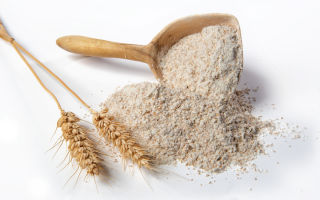Content
- 1 How whole grain flour is obtained
- 2 Whole Wheat Flour Types
- 3 The chemical composition and calorie content of whole grain flour
- 4 Whole Grain Flour Benefits
- 5 Whole grain flour for weight loss
- 6 How to make whole grain flour at home
- 7 Features of baking with whole grain flour
- 8 How to make whole wheat bread
- 9 Harm of whole grain flour and contraindications
- 10 Conclusion
Bread occupies the first positions in the diet of most people, therefore special attention should be paid to its quality. Nutritionists unanimously say that the properties of bread made from whole grain flour are uniquely beneficial for the body and it can be eaten even by people on a diet. It is high in amino acids, fiber, vitamins and minerals. Let's take a closer look at the benefits and harms of whole grain flour, how to bake bread at home, and to whom such baking is contraindicated.
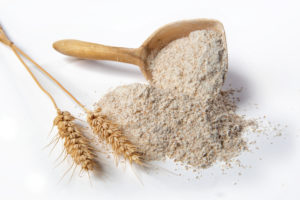
How whole grain flour is obtained
Whole grain, or wholemeal, flour is made from unrefined grains, which are ground together with the flower coat and grain germ, and then not sieved. That is, all the constituent grains go into food and, despite some roughness of the resulting product, it is called wallpaper flour, or one-time grinding, and is considered an incredibly healthy product.
The benefits of the product directly depend on the very technology of grain grinding.
There are two ways to grind:
- With the use of iron rolling machines. Flour, released from the roller machines, retains only 40% of useful substances. This method destroys the shell and the germ at the molecular level, therefore, not only the beneficial properties of whole grain flour are reduced, but also its quality.
- Using stone millstones. Flour from under the stone millstones most fully retains its properties, since this method does not destroy the structure of wheat. This method of obtaining the product saves five times more fiber, twice as much minerals, and 1.5 times more vitamins, compared to the first method.
Whole Wheat Flour Types
Wheat wholemeal flour is divided into two types, depending on the percentage of the content of the fruit shell and grain germ:
- wallpaper - contains up to 96% of the original raw materials. In its manufacture, the shell and the embryo are partially sifted out, this is necessary to align the fractions in size;
- whole grain - contains 100% of the original raw materials. Since it is not sieved, it has non-uniform particles.
Wallpaper flour has the best baking properties precisely due to the homogeneity of the fractions, therefore it is in great demand. The benefits of whole grain flour are higher, but their baking properties are slightly different, and this should be considered when baking bread.
The chemical composition and calorie content of whole grain flour
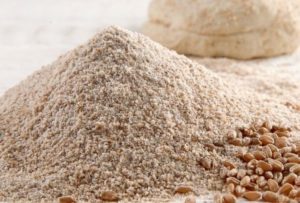
Compared to high-quality flour, whole grain has a richer chemical composition, which is why its benefits are estimated higher. The composition includes such trace elements as potassium, magnesium, calcium, phosphorus, sodium, iodine, copper, zinc, iron, as well as vitamins - P, PP, E, H, A, B vitamins and beta-carotene.
Wallpaper flour has a rather high nutritional value: 100 g of the product contains 312 kcal. In percentage terms, it looks like this:
- proteins - 14%;
- fats - 6%;
- carbohydrates - 78%.
In addition, it contains a large amount of plant fibers and pectin substances that improve metabolism. Therefore, in spite of its calorie content, such flour does not harm health.
Whole Grain Flour Benefits
The beneficial properties of wallpaper flour are due to the wheat milling method, which preserves the entire complex of biologically active substances. Therefore, regular consumption of whole-grain grain products completely replenishes the supply of minerals and vitamins in the body, and also relieves many diseases (obesity, diabetes mellitus, intestinal upset, atherosclerosis, etc.).
What are the health benefits of whole wheat wallpaper flour:
- fiber helps to remove heavy metals, toxic substances and radioactive compounds from the body, improves intestinal motility;
- lowers blood sugar, because the product is considered beneficial for people with diabetes;
- the properties of trace elements included in the shell and wheat germ have a positive effect on the work of the cardiovascular system;
- improves memory and vision, has a beneficial effect on the functioning of the nervous system;
- is the prevention of oncological diseases.
Scientists have found that the properties of wallpaper flour have a positive effect on the production of endorphins (hormones of happiness), so the product will be useful for people with various nervous disorders.
Whole grain flour for weight loss
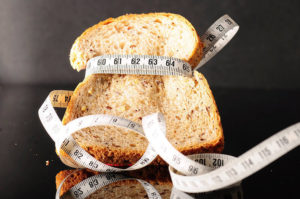
The benefits of whole grain are invaluable for those who are overweight due to their high fiber content. The product has a low glycemic index, and the properties of fiber slow down the absorption of glucose and normalize blood sugar levels.
In addition, fiber saturates well, gives a feeling of fullness for a long time and is practically not absorbed by the body. It has a beneficial effect on bowel function, normalizes stool, which is important for people on a diet.
For people who are losing weight, a high concentration of essential vitamins and minerals of whole grain bread will also be useful, which, due to the refusal of certain foods, the body has nowhere else to take: so that the diet is not harmful to health, such a product should be in the diet every day.
How to make whole grain flour at home
A useful product can be obtained without any particular difficulties at home: the process does not require special knowledge and skills.
For this you need:
- Whole grain of wheat. Before grinding, prepare the wheat: rinse, dry (at least 10 - 12 hours), select rotten and spoiled grains.
- Special mill (you can take an electric blender or coffee grinder). Fill the container to half and grind, then separate the coarse fractions with a small sieve and grind them again.
- The finished flour must be dried. To do this, it is laid out with a layer of 1.5 - 2 cm on paper and left for 24 hours in a dry place, periodically stirred. As soon as it stops sticking to your hands, pour it into a paper bag (cloth bag) or use it as directed.
If there is no special kitchen equipment at hand, you can get this useful product in an ordinary mortar. However, this very laborious process will take a long time.
The benefits and harms of whole grain wheat flour largely depend on how you make it. So, the benefits of a product obtained, for example, in a mortar, will be an order of magnitude higher than in a coffee grinder. This is due to the fact that in a coffee grinder or blender during the grinding process, the raw material heats up, and this has a negative impact on its beneficial properties.
Features of baking with whole grain flour
The product has some features that should be considered when making baked goods:
- the dough does not rise well and may fall off due to its high fiber content.The product at the exit turns out to be coarse, therefore, wallpaper flour is not used in the preparation of buns. Most often it is used to make hearth bread, muffins or tortillas;
- before kneading the dough, the flour should be dried and sieved to saturate it with oxygen;
- Whole grain dough requires more moisture, since large fractions absorb liquid: therefore, according to the recipe, a little more liquid is added to such a dough;
- the finished dough cannot be sent directly to the oven, it needs to be infused so that the moisture is completely absorbed: then the product will turn out to be more fluffy and airy;
- make the dough bookmark 50% otherwise the baked goods will not rise and bake.
To improve the structure of the dough, it is recommended to add a little premium flour. It will not cause significant harm to people on a diet, and the result of baking will be more predictable.
How to make whole wheat bread
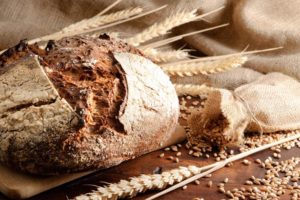
Cooking from wallpaper flour is no more difficult than from varietal flour. The benefits of whole grain bread are enormous, and every housewife should master this art.
To prepare the dough you will need:
- flour - 570 g;
- dry yeast - 2 tsp;
- salt - 2 tsp;
- sugar - 1 tsp;
- water - 400 ml.
Cooking method:
- In a bowl, mix all dry ingredients (flour, sugar, salt).
- Make a funnel in the center and pour in yeast diluted with warm water, then add water in a thin stream, stirring constantly;
- Knead the dough with your hands until smooth and place in a mold, sprinkle with flour on top.
- Cover with a clean towel and place in a warm, dry place to rise for 40 - 45 minutes.
- Send to oven preheated to 200 ° C and bake for 40 minutes.
- Remove the pastry from the mold, turn it over and bake for another 5 - 7 minutes. for the formation of a golden crust.
The finished bread, covered with a towel, should cool at room temperature, and only after that it can be put into the bread bin.
Harm of whole grain flour and contraindications
Despite the benefits of whole grain bread, in cases of contraindications from its use, harm to health is possible:
- people with intestinal adhesions;
- suffering from gastritis, stomach ulcers;
- with acute inflammatory gastrointestinal infections.
Large fractions can harm the injury to the intestinal mucosa of young children, so it should be added to the diet with caution.
In addition, along with the pieces of grain, there is a possibility of penetration of harmful bacteria into the body, which did not die during baking. Therefore, for people with a weakened immune system, such baked goods can also harm the disruption of the digestive system and intestinal microflora.
Conclusion
The benefits and harms of whole grain flour depend on the quality of the whole grain and how it is ground. For a healthy person, baking from whole wheat gives a wealth of nutrients. In pursuit of taste, people began to make flour from refined wheat, forgetting that all the benefits lie in the fiber of the husk. It is enough to eat one or two slices of whole grain bread a day in order to significantly improve the support of the body with necessary microelements.

